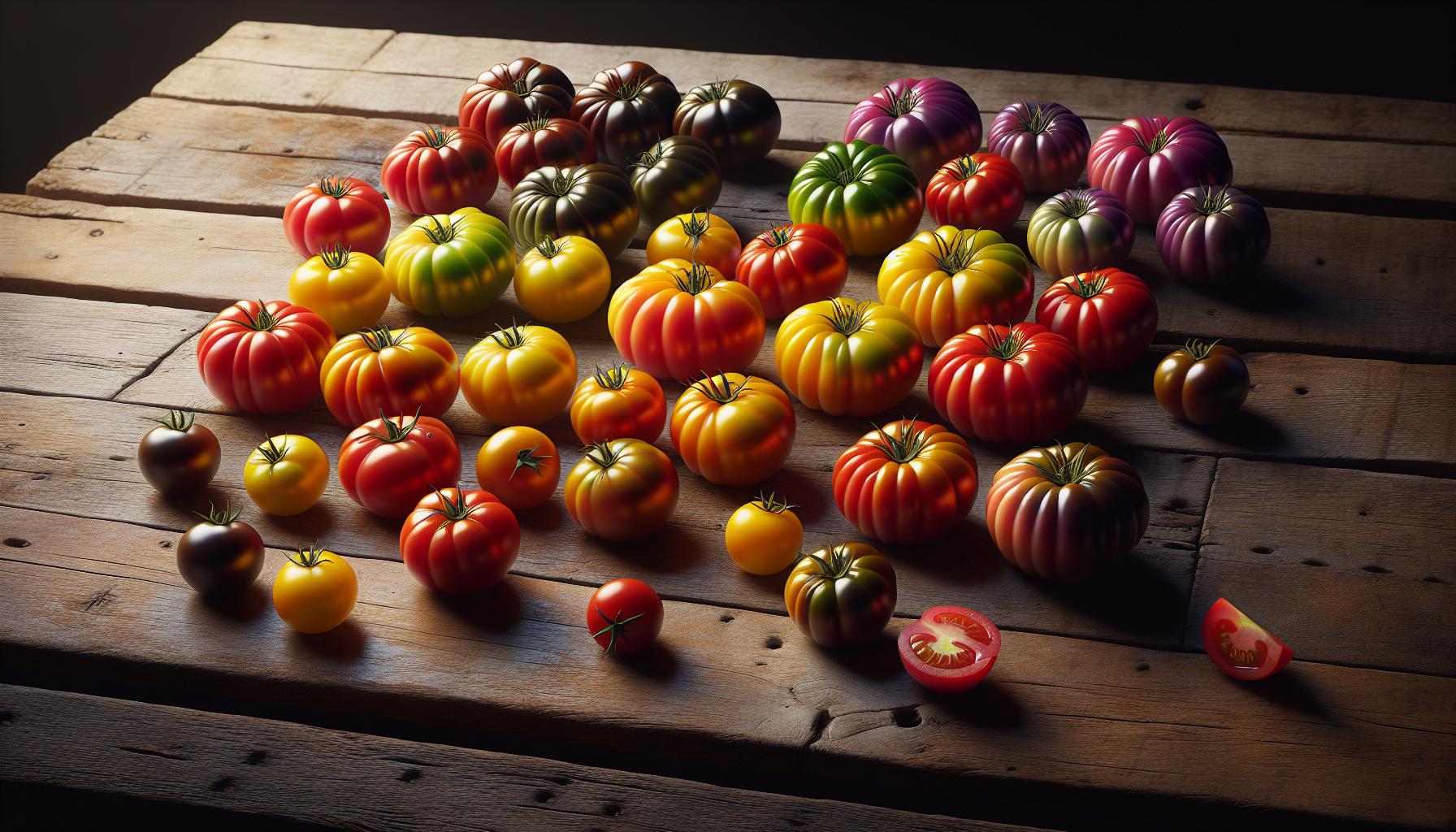As summer winds down, knowing when to harvest tomatoes becomes crucial for every home gardener. Picking them too early means hard, bitter fruit, while waiting too long risks splitting, rot, or hungry birds. Timing is everything if you want that perfect juicy bite.
In this text, I’ll guide you through the signs that indicate it’s time to pick your tomatoes, whether they’re cherry, beefsteak, or still green. By understanding these cues, you can ensure your harvest is at its peak flavor and texture. Let’s jump into the essentials of tomato harvesting and make the most of your garden’s bounty.
Understanding the Ripeness of Tomatoes
Signs of Ripeness
Knowing when a tomato is ripe ensures a tasty, juicy harvest. A ripe tomato often shows uniform color across its surface. It should feel firm yet yield slightly under gentle pressure. The fruit’s aroma also changes, becoming more intense and typical of a tomato. Also, a ripe tomato detaches from the vine with a gentle tug, avoiding any unnecessary damage to the plant or other fruits.
Stages of Tomato Ripeness
Understanding the ripening stages helps determine the best time to pick your tomatoes. Here are the key stages:
1. Mature Green Stage
At this stage, tomatoes are fully grown but still entirely green. They might not develop their full flavor if harvested now. But, they can ripen indoors if necessary, especially when temperatures drop and there’s a risk of frost.
2. Breaker Stage
In the breaker stage, up to 10% of the tomato’s surface shows color, such as pink, red, or yellow. This stage marks the beginning of ethylene production, which is the natural ripening hormone. Picking tomatoes at this stage reduces risks from cracking, insect damage, and sunscald. They can fully ripen off the vine.
3. Turning Stage
Between 10% and 30% of the tomato’s skin is now colored. The fruit is starting to soften, and its flavor begins to develop. This stage is ideal for picking if you want them to ripen indoors, ensuring prolonged shelf life and minimal exposure to potential plant stressors.
4. Pink Stage
At the pink stage, 30% to 60% of the tomato’s surface is colored. The fruit feels slightly soft and is developing better flavor. It can still be picked and ripened further indoors without losing much quality.
5. Light Red Stage
The light red stage means 60% to 90% of the tomato’s skin shows its mature color. The fruit is very close to being fully ripe. This is the point where tomatoes can be harvested for immediate use or short-term storage. They have a rich flavor and are more susceptible to cracking if left on the vine any longer.
6. Red Stage
At this final stage, 90% or more of the fruit’s surface is fully colored. The tomato has reached peak flavor and juiciness. Harvesting at this stage offers the best taste but also means the fruit should be consumed soon, as it won’t last as long off the vine.
By monitoring these stages and understanding the signs of ripeness, I can ensure a bountiful and timely tomato harvest that enhances both flavor and texture.
Factors Influencing Tomato Harvest Time

Understanding the factors influencing tomato harvest time helps ensure a flavorful and juicy yield. Key elements to consider are weather conditions and the specific tomato variety.
Weather Conditions and Their Impact
Weather significantly affects tomato ripening. Excessive rain, especially after a dry spell, can cause tomatoes to crack or split. High temperatures hasten ripening, whereas cooler temperatures can slow it down. If a heavy rainstorm is forecasted, picking nearly ripe tomatoes ahead of time and letting them ripen indoors might save them from splitting.
Drought conditions put extra stress on tomatoes, causing the flesh to grow faster than the skin, which may lead to splitting after sudden rainfall. To avoid this, maintain consistent soil moisture throughout the growing season. Monitor weather patterns closely and adjust your harvesting schedule to mitigate the adverse effects of extreme weather conditions.
Tomato Variety and Ripening Characteristics
Different tomato varieties ripen at different rates and exhibit unique ripening signs. Heirloom tomatoes often take longer to ripen than hybrid varieties, and their ripening patterns can be less uniform. Knowing these characteristics helps in determining the optimal harvest time.
Heirloom varieties may show a variety of colors when ripe, ranging from red and pink to yellow and even purple. Hybrid tomatoes often have more predictable ripening signs, like a uniform red color. Feel the tomato gently; a slight give when pressed indicates ripeness. For larger varieties, look for full color development and ease of detachment from the vine. Smaller types, like cherry tomatoes, should display a bright, vibrant color and easily come off the stem.
Consistent observation and knowledge of specific varieties ensure that you pick tomatoes at their peak ripeness. This guarantees a rich flavor and juicy texture, making your tomato harvest both rewarding and delicious.
Harvesting Techniques for Tomatoes

Harvesting tomatoes correctly ensures you get the best flavor and quality from your plants. There are specific techniques to pick them gently and strategies for dealing with unripe tomatoes that can maximize your yield.
How to Pick Tomatoes Gently and Efficiently
Picking tomatoes requires a gentle touch to avoid bruising the fruit or damaging the plant. I always follow these steps:
- Check Ripeness: First, I make sure the tomato is ripe. A ripe tomato will have a rich color and a slight give when gently squeezed.
- Use Two Hands: One hand supports the tomato, and the other hand gently twists the fruit to detach it from the vine. This prevents snapping the vine, which can affect future fruiting.
- Harvest Regularly: I conduct regular checks, every couple of days, to ensure tomatoes are picked at their peak ripeness. This also encourages the plant to produce more fruit.
- Be Mindful of Weather: If rain is forecasted, I harvest nearly ripe tomatoes. Heavy rain can cause the fruits to split, especially if the weather has been dry.
Regular and careful picking ensures a continuous supply of tomatoes without damaging the plant.
Strategies for Harvesting Unripe Tomatoes
Sometimes, tomatoes need to be picked before they’re fully ripe. Here’s what I do:
- Monitor Weather Conditions: If a heavy rainstorm is expected, I pick tomatoes that are nearly ripe to avoid splitting. These tomatoes can finish ripening indoors.
- Check for Color Change: I look for tomatoes that have a hint of their mature color, even if they are still firm. These “breaker” stage tomatoes can ripen off the vine.
- Use Ethylene: To ripen tomatoes indoors, I place them in a breathable paper bag with a banana. The banana emits ethylene gas, which accelerates ripening.
- Avoid Direct Sunlight: I keep harvested tomatoes out of direct sunlight since it can cause uneven ripening and potential spoiling.
By following these strategies, even unripe tomatoes can develop their full flavor and texture.
These techniques ensure that my tomato harvests are successful, yielding tasty fruits while maintaining the health of the plants.
Post-Harvest Handling of Tomatoes

How to Ripen Tomatoes After Picking
After picking tomatoes, especially if they were harvested at the mature green stage, proper ripening ensures flavor and texture. To ripen tomatoes, place them in a single layer in a warm, well-ventilated area out of direct sunlight. A good spot is a kitchen counter or pantry.
Put tomatoes in a paper bag if you need to speed up the ripening process. Adding a ripe banana or apple to the bag can help produce ethylene gas, which promotes ripening. Check tomatoes daily to monitor progress and avoid overripening.
Handle the tomatoes gently to prevent bruising, which can lead to spoilage. If some tomatoes show signs of splitting or soft spots, use them quickly to minimize waste.
Storage Tips for Prolonging Freshness
Once tomatoes are fully ripe, extend their freshness with proper storage. Keep them in a cool, dark place, like a cellar or a refrigerator. But, refrigerate only if necessary, as cold temperatures can alter the texture and flavor.
Store tomatoes stem-side down to reduce moisture loss and prevent molding. If storing in the fridge becomes necessary, allow them to come to room temperature before use to regain some flavor and softness.
For longer storage, consider canning or freezing. Blanch tomatoes briefly, remove the skins, and freeze them in airtight containers or bags. This preserves their taste and nutritional value for extended periods.
These techniques help maintain the quality of your tomatoes after harvest, ensuring you enjoy them at their best.
Conclusion

Understanding when and how to harvest tomatoes involves a good sense of timing and observation. Picking tomatoes at the right moment ensures they are flavorful and juicy. Typically, a ripe tomato will have a uniform color and a slight give when gently squeezed. Some varieties, like Early Girl and Glacier, can ripen in about 50 to 60 days after transplanting, whereas main-season varieties might take 70 to 80 days or more.
If you’re unsure about the ripeness, it’s usually better to pick the tomato early. Tomatoes continue to ripen off the vine at room temperature. You can place green tomatoes in a paper bag with a ripe apple or banana to speed up ripening, as these fruits release ethylene gas, which helps ripening.
Temperature plays a crucial role in tomato ripening. Keeping a consistent temperature is essential to avoid issues like splitting or blossom end rot. If picked too late, tomatoes might become overripe or subject to pests and diseases.
For stubborn stems, use garden shears to avoid damaging the plant. Handle tomatoes delicately to prevent bruising. Post-harvest care includes storing tomatoes in a cool, dark place to prolong freshness. If you have many tomatoes, consider canning or freezing them to enjoy later.
Summarizing, harvesting tomatoes requires attention to detail and an understanding of growth and environmental factors. By mastering these techniques, you can enjoy a plentiful harvest of delicious tomatoes from your garden.

